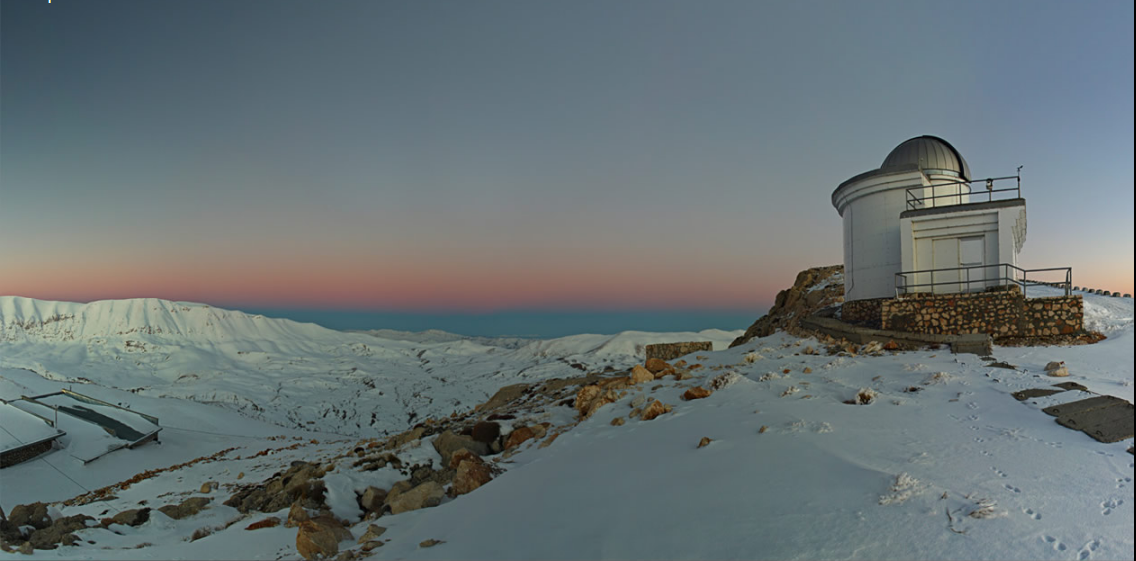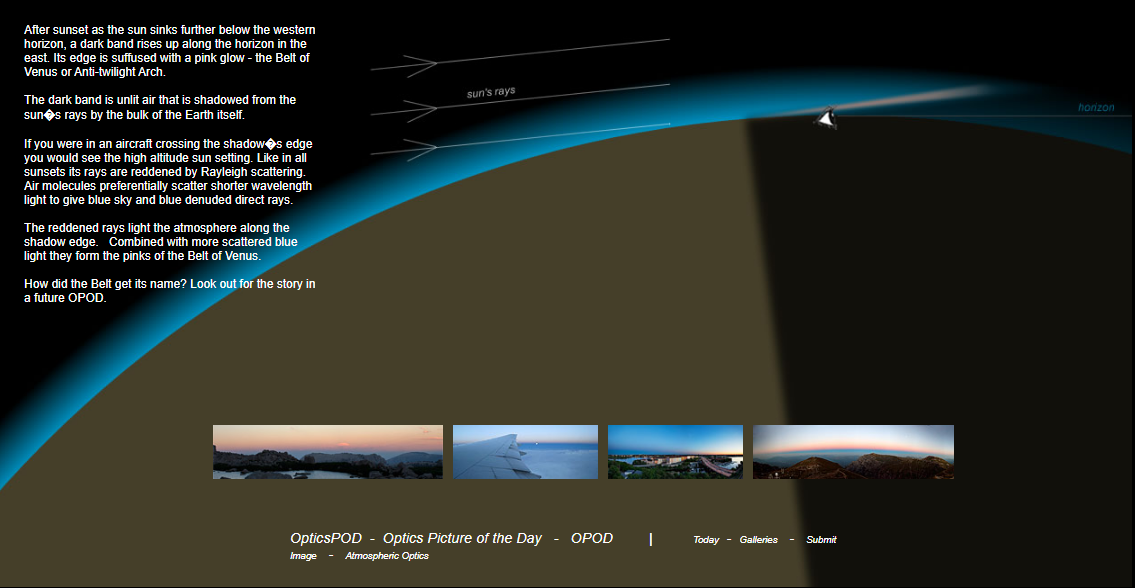OPOD - Belt of Venus
The Belt of Venus: A Beautiful Atmospheric Phenomenon
Have you ever noticed a captivating pink glow along the horizon after sunset? This mesmerizing sight is known as the Belt of Venus or Anti-twilight Arch. As the sun sinks below the western horizon, a dark band rises in the east, its edge suffused with a delicate pink hue. But what exactly causes this enchanting atmospheric phenomenon?
The dark band of the Belt of Venus is actually unlit air that is shadowed from the sun's rays by the bulk of the Earth itself. If you were in an aircraft crossing the shadow's edge, you would witness a high altitude sunset. Just like any other sunset, the sun's rays become reddened due to Rayleigh scattering, where air molecules scatter shorter wavelength light, resulting in the blue sky and blue denuded direct rays we observe during the day.
As the reddened rays from the setting sun illuminate the atmosphere along the shadow's edge, they combine with more scattered blue light to create the beautiful pink hues of the Belt of Venus. The interplay between these reddened and scattered rays gives rise to this ethereal phenomenon that captivates observers worldwide.
But how did the Belt of Venus acquire its name? Unfortunately, the story behind its intriguing name remains a mystery for now. However, stay tuned for a future OPOD (Optics Picture of the Day) where you might uncover the fascinating origins of this atmospheric marvel.
To delve deeper into the enchanting Belt of Venus, let's explore some additional details:
The Science Behind the Belt of Venus
- The Belt of Venus is most prominently visible during twilight, after sunset or before sunrise when the sun is below the horizon but still illuminates the atmosphere.
- The phenomenon occurs when sunlight passes through the Earth's atmosphere at a low angle, causing the shorter wavelength blue light to scatter away while longer wavelength red light persists.
- The scattered blue light combines with the reddened rays of the setting or rising sun, creating the pinkish glow along the horizon.
- The Belt of Venus is typically seen opposite the setting or rising sun, appearing as a horizontal band above the dark shadow of the Earth's surface.
Observing the Belt of Venus
To witness the captivating Belt of Venus for yourself, here are a few tips:
- Find a location with an unobstructed view of the eastern horizon during twilight.
- Choose a clear evening with minimal atmospheric pollution for optimal visibility.
- As the sun dips below the western horizon, direct your gaze towards the east and look for the dark band gradually rising along the horizon, adorned with its characteristic pink glow.
Similar Atmospheric Phenomena
While the Belt of Venus is a unique and enchanting sight, it shares similarities with other atmospheric phenomena:
- The Earth's Shadow: Just below the Belt of Venus, you may notice a darker band known as the Earth's Shadow. This shadow is caused by the Earth itself blocking the sun's direct rays.
- Alpenglow: This phenomenon occurs when mountains or other elevated objects reflect and scatter sunlight after sunset, resulting in a warm reddish glow on their peaks.
- Crepuscular Rays: Also known as "sunrays," these are beams of sunlight that appear to radiate from the point in the sky where the sun is located. They are often visible during twilight and can create stunning visual effects.
Capturing the Beauty
If you're passionate about photography, capturing the ethereal beauty of the Belt of Venus can be a rewarding challenge. Here are some tips to help you get started:
- Use a tripod to stabilize your camera and avoid blurry images.
- Experiment with different exposure settings to capture the subtle color variations and details of the Belt of Venus.
- Consider including interesting foreground elements, such as silhouetted trees or buildings, to add depth and context to your photographs.
In conclusion, the Belt of Venus is a captivating atmospheric phenomenon that enchants observers with its delicate pink glow. As the sun sets or rises below the horizon, the interplay between scattered blue light and reddened rays creates this mesmerizing spectacle. Whether you're an avid sky-watcher or simply appreciate the beauty of nature, the Belt of Venus is a sight worth experiencing. So, don't forget to keep an eye out for this enchanting phenomenon during your next twilight adventure!

Belt of Venus Imaged by M. Raşid Tuğral at the T�BITAK National Observatory, Turkey. The observatory is ~50km NW of Antalya on a 2500m peak in the West Taurus Mountains. ©M. Raşid Tuğral, shown with permission.
After sunset as the sun sinks further below the western horizon, a dark band rises up along the horizon in the east. Its edge is suffused with a pink glow - the Belt of Venus or Anti-twilight Arch.
The dark band is unlit air that is shadowed from the sun�s rays by the bulk of the Earth itself.
If you were in an aircraft crossing the shadow�s edge you would see the high altitude sun setting. Like in all sunsets its rays are reddened by Rayleigh scattering. Air molecules preferentially scatter shorter wavelength light to give blue sky and blue denuded direct rays.
The reddened rays light the atmosphere along the shadow edge. Combined with more scattered blue light they form the pinks of the Belt of Venus.
How did the Belt get its name? Look out for the story in a future OPOD.

Note: this article has been automatically converted from the old site and may not appear as intended. You can find the original article here.
Reference Atmospheric Optics
If you use any of the definitions, information, or data presented on Atmospheric Optics, please copy the link or reference below to properly credit us as the reference source. Thank you!
-
<a href="https://atoptics.co.uk/blog/opod-belt-of-venus/">OPOD - Belt of Venus</a>
-
"OPOD - Belt of Venus". Atmospheric Optics. Accessed on November 12, 2024. https://atoptics.co.uk/blog/opod-belt-of-venus/.
-
"OPOD - Belt of Venus". Atmospheric Optics, https://atoptics.co.uk/blog/opod-belt-of-venus/. Accessed 12 November, 2024
-
OPOD - Belt of Venus. Atmospheric Optics. Retrieved from https://atoptics.co.uk/blog/opod-belt-of-venus/.